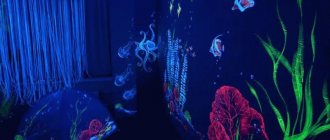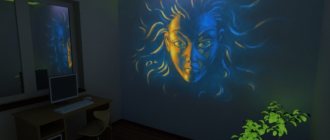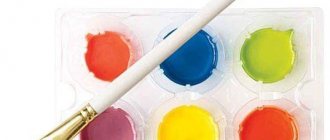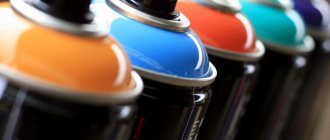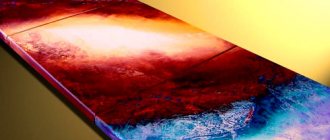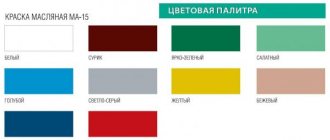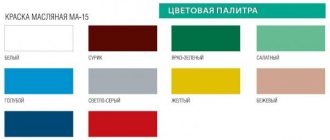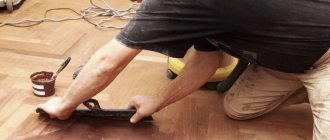Glowing paint can be a source of inspiration and material for creating unique decorative effects. It glows in the dark, turning an ordinary room into a fabulous place. But not only the interior is decorated with this paint. Luminescent pigment will help give an unusual look to any surface or object. And at the same time, the luminous composition is easy to prepare with your own hands at home.
What is luminescent paint and how does it work?
Luminescence is the ability of a substance to glow in the dark due to previously accumulated light energy. Luminescent paint contains substances such as luminous pigments (luminophores). They “accumulate light” during the day or while artificial lighting is on. And when darkness sets in, the bright glow of the painted surface becomes noticeable.
Important! Luminescent (luminescent, self-luminous) compositions should not be confused with fluorescent paints. The latter can glow only under the influence of ultraviolet rays (you need to buy special lamps for them).
Luminescent paints glow in the dark due to the accumulated light energy.
The process of accumulation and release of light energy by the phosphor is reversible, so the luminous paint will “work” for years. Phosphor is a physically and chemically stable substance that will last at least 30 years even outside the building. In this case, only 15–20 minutes of “recharging” with bright light is enough for the painted surface to glow for about 8 hours. The brightness of the glow depends on the concentration of the phosphor in the paint.
According to the principle of action, luminescent materials are similar to phosphorescent ones. But the latter contain phosphorus that is hazardous to health. Therefore, they are used very rarely and only for outdoor work. But phosphor-based materials are completely safe.
Phosphor pigment, in powder form. Player #13 is White green. And personal impressions of him.
This review is dedicated to a wonderful time in the life of every person - childhood - and to those people who brought back to me the long-forgotten feelings of 1986.
Hello. Dear users of the resource. This product has already received enough attention on mysku. But so far there seems to be no punishment here for repeated reviews of products. Therefore, I would like to remind you of an excellent and very recent review, which was an incentive for me to purchase this product mysku Since the order was placed and paid for back in March, this fact has already faded somewhat in my memory, erased, giving way to more recent impressions. Therefore, when a bag of white powder fell out of another yellow envelope, the first thought was – Cocainum... A setup... Now they will break down the door. How can I run to the toilet in time? With a powerful effort of will, in those seconds when episodes of an entire righteously lived life flashed at breakneck speed before the mind’s eye, somewhere in the middle of childhood memories, an episode with an order for this luminous powder was caught. But the stress was so intense that I did not immediately allow myself to touch the bag a second time. But still, I took myself and the bag in my hands and propose to see what the seller sent. The seller honestly put a portion of the product weighing 10 g into the bag, however, for unknown reasons, he cheated slightly on the product page, making the appearance of the bags in the photographs more voluminous.
There is a good write-up about phosphors-fluorescents-reflective pigments here enter Since the layer holding the phosphor must be transparent (how else would it be charged) - for myself, I have identified 2 options for fixing powder particles in a solid layer. 1. By mixing the powder with glue (for example, stationery, PVA) or with colorless varnish (furniture, nail polish).
2. By placing powder particles on a layer of adhesive tape and then fixing it on top with the same tape. The end result is something like this sandwich.
Naturally, it is better not to apply it to your epidermis. But you can try making a firefly out of a fly. Some buyers use the product to illuminate the “throne” meeting room, but I am content with unobtrusive LED lighting based on a pair of cuteo diodes. But using the composition to mark the elements of the electrical panel, so that during a power outage it is better to hit the target (check machines) - the idea seems quite good to me successful. In short, the main application points are decor, entertainment and safety. Taking into account the fact that the applied light composition can change the appearance of the object - and not for the better. You definitely need to think about preserving aesthetics.
We’ll apply it, we’ll find where, sooner or later. It would be a fantasy. And powder. Most of all, to be honest, I was interested in the question of the duration and brightness of the glow of the powder in the dark.
The result of repeated assessment of these indicators was quite acceptable, although it was based solely on visual assessment coupled with timing. Experience showed that in a dark room the powder retained its ability to glow quite brightly from 23.20 to approximately 05.00. At 7.00 it no longer glowed at all. What happened in the interval from 5 to 7 remained a mystery, because Morpheus repeatedly stopped my attempts to understand this time interval. I don't think you can unconditionally extrapolate this data to other colors or batches of the same powder. But, nevertheless, a fact is a fact. Also, experimentally it was possible to establish that the protective plastic cover of the electrical panel is not an obstacle to “recharging” the powder during daylight hours. Because The layer of powder in the bag is quite thick; part of the bottom side does not receive enough light quanta when illuminated and, accordingly, does not emit them itself. Mixing the dark and light factions in a bag (the fight between good and evil) is also a kind of additional fun from the purchase.
Children's stories about phosphorus and, especially, radioactive isotopes in relation to this powder, of course, are stories. There is nothing like that there and there is no trace of enter. Otherwise, the goods would be expropriated by the relevant structures on the way to the addressee.
Comrades from the People's Republic of China widely use substances that glow in the dark, both in liquid form (for example, filling mysku. pendants) and in solid form - in the form of this powder and adhesive tapes. The latter, in my opinion, are more convenient to use, so I also ordered this tape from ebay
Of course, I won’t buy this product again; this small bag is enough for me to pamper myself. I remembered my childhood, when I dreamed of cars with luminous headlights and watches with luminous hands (do they make that same “Polyot” now?) and became nostalgic.
It is difficult to hook modern children with this powder. They have smartphones and are not capable of such a glow. For me, this fun is akin to playing with smart plasticine.
I had fun and put it on the shelf. When the Chinese learn how to make the wonderful powder according to Oorfene Deuce’s recipe, then I will buy it with pleasure. Well, of course, I’ll post a review on it. If the idiots don't mind. But I don’t want this powder anymore. Although, to be honest, 50 rubles is absolutely not a pity. Even if only for such a small packet of it. Best wishes from N.N. on this joyful day...
Scope of application of luminous paints
In addition to the phosphor itself, the luminous paint includes a transparent varnish (it acts as the basis of the material). The area of application of a particular composition depends on the properties of the varnish. It can be selected for almost any surface - metal and plastic, drywall and wallpaper, concrete and plaster, textiles and wood, glass and ceramics.
On a note! The luminous composition can be applied to fresh flowers and used for body art. But it must be a water-based acrylic dispersion that is safe for health.
Glowing paints are often used when performing body art work.
Luminescent paint is used:
- when applying road markings, painting fences and road signs;
- for decorating interior surfaces (applying drawings to walls, ceilings, floors);
- for painting furniture and other interior elements;
- in make-up, stage art, in the creation of theatrical costumes and scenery;
- in floristry;
- in the production of advertising products (from signs to souvenirs);
- in landscape design (from painting gazebos and fences to creating complex patterns on facades);
- in tuning cars, bicycles, motorcycles (for airbrushing, painting wheels, hubcaps, bumpers, spoilers);
- for the production of workwear for road and emergency services workers.
Car tuning is one of the areas of application of luminous paint
Types of paints
Some of its characteristics and ease of use depend on the type of dye.
By composition
Based on their composition, 3 types of luminescent paints can be distinguished:
- Acrylic . Water-based, odorless paint. Suitable for indoor use as well as outdoor use. It dries quickly and is not afraid of moisture and temperature changes.
- Inert enamel . Made on a polyurethane base. For indoor use, different colors can be mixed. It fits perfectly on top of wood, gypsum board and plaster. It has high strength and is often used in specialized areas: finishing roads, creating work clothing.
- Ink . They are used in interior printing, when creating advertising products, in art and design. You can use fluorescent paints that are activated only by UV rays.
By release form
The products are produced mainly in three types:
- Aerosol . Sold in cylinders. The composition includes an acrylic base. Used for working on large areas.
- Powder . In dry form it is added to conventional paints.
- Liquid paint in jars . Sold in small containers for creative work.
When creating one project, you can combine different forms of luminescent paints.
How to choose composition and color
The choice depends on the scope of work and purpose.
The choice of paint type depends on what it will be used for:
- a large area will be processed - walls, furniture, car surfaces or the entire bicycle frame - select the composition in cans;
- if you need to cover a small part , then choose liquid paint in jars;
- when creating complex large patterns, you can use pigments in buckets, applying them with paint brushes and rollers;
- for paint used on skin and clothing , there is one requirement - a safe water base;
- to cover plastic , you should choose special polyurethane-based enamels;
- If you need high-quality paint , then when purchasing, you should check the certificate from the seller.
The choice of fluorescent paint colors is limited. Most manufacturers offer 8-10 base tones. However, they can be mixed to create original combinations.
If you want to combine different shades, it is important to remember that combining compositions from different manufacturers is unacceptable.
When choosing a color, there is another parameter - the intensity of the glow. Achromatic shades under the influence of ultraviolet become rich and bright, and without it they are invisible to the eye. Chromatic colors become very bright under the influence of rays.
Valera
The voice of the construction guru
Ask a Question
Opaque paints can change shade in the dark. Most manufacturers offer samples that are natural in color and develop at night or when exposed to ultraviolet light. A subtle pastel pink can glow with both lilac and magenta in the dark.
Types of luminescent paint
All compositions on the market can be divided into two large groups:
- Colorless (or translucent). These are varnishes that are practically invisible in daylight. They can be applied over any “visible” pattern.
- Colored. In addition to the phosphor, these enamels contain a coloring pigment (color). During the day they look like regular paints, but at night they glow.
There is a large assortment of luminescent paints on the market.
Also, luminescent paints and varnishes differ in the composition of the base and performance properties. Among them are:
- Polyurethane-mineral enamels. They have high adhesion and are suitable for painting various plastics.
- Water-dispersed (acrylic) emulsions. Safe and dry quickly.
- Heat-resistant paints. They create coatings that can withstand heating up to +500 °C. Good for painting metal structures, glass, ceramics.
- Waterproof compounds. Create a thin waterproof film on the painted surface. Used for painting swimming pools, drainage systems, and bathroom elements.
Area of application of luminescent paint, features of working with it
Glow in the dark acrylic paints have different applications.
One of the most popular areas of application is interior decor. The walls painted with luminescent paints look amazing. The trick of this type of painting is that in daylight the paints are either not visible at all or create a light translucent coating. However, as soon as you turn off the light, the surfaces painted with luminous paint take on a fabulous look. In addition, if you cover light switches with luminescent paint, they are much easier to find in a dark room.
Floral arrangements of indescribable beauty are obtained by applying a small amount of luminous paint to the flower petals. Makeup and manicure with the addition of luminescent paint, body art and makeup look original and bold. Clothes decorated with such paint will make its owner stand out in the crowd at a party and will protect him on the road at night. Wherever luminescent paint is applied, it will add uniqueness to the created image.
The author of the article is Olga Vasilievskaya, “Decoupage. Materials, training. Yaroslavl".
How to make glowing paint from phosphor powder?
You can make paint with a glow effect with your own hands. To do this, you need to buy a phosphor, select a transparent varnish and a solvent for it. You will also need ceramic or glass dishes for mixing the ingredients.
The phosphor of the desired color can be found on the Internet or a building materials store. It is quite expensive, but 100 g of this powder is enough to completely color about 8 square meters. m of surface. The price depends on the color of the glow: pigments in light green, blue and white shades are cheaper, but brighter ones - red, orange, blue, green - are more expensive.
Phosphor - luminous powder for making luminescent paint
Important! The varnish should be chosen according to the surface that will be painted. This is the only way the finished paint will adhere well.
How to make glowing paint at home:
- Pour varnish into the dishes.
- Add powdered phosphor (the ideal ratio is when the composition consists of 70% varnish and 30% luminous pigment).
- Add a little solvent to the mixture (up to 1% of the total mass).
- Stir thoroughly.
- If you need to get a colored composition, color is also added to the dishes.
Materials and tools necessary for preparing luminescent paint
Paint made in this way is used and stored in the same way as regular varnish of a similar type.
Making your own phosphor
If you really want to, you can make your own phosphor. True, this will require more effort and special reagents. What do we have to do:
- Take pine concentrate and dissolve it in clean water in a ratio of 1:50. The finished solution should have a yellow tint.
- Pour 2-3 g of boric acid into a heat-resistant bowl with a wide bottom.
- Place about 10 drops of pine solution on the powder.
Coniferous concentrate is the main component that affects the glow of homemade phosphorOn a note! The color and intensity of the glow of the resulting phosphor will depend on the concentration of the pine extract. Therefore, it can be varied to achieve the desired effect.
- Mix the resulting mixture thoroughly and level it over the bottom of the dish in a layer no thicker than 4 mm.
- Place the dishes on the electric stove and dry over low heat.
- After the water evaporates, the mixture will begin to melt and bubbles will appear on its surface. They should be pierced.
- When the mixture is completely melted, it must be removed from the stove and left at room temperature until it cools completely.
- Grind the frozen crust into powder. This will be the phosphor, which can already be mixed with transparent varnish and used for its intended purpose.
Before making a phosphor, you should calculate the required volume of luminous paint. It is quite possible that it will be easier and cheaper to buy ready-made material in a store. In addition, “branded” paint will always be of higher quality than artisanal paint, and the color of the glow can be selected immediately, without lengthy experiments. And having one or several jars of luminescent paint in your arsenal, it’s easy to create an unusual thing, stylish tuning or a unique interior.
